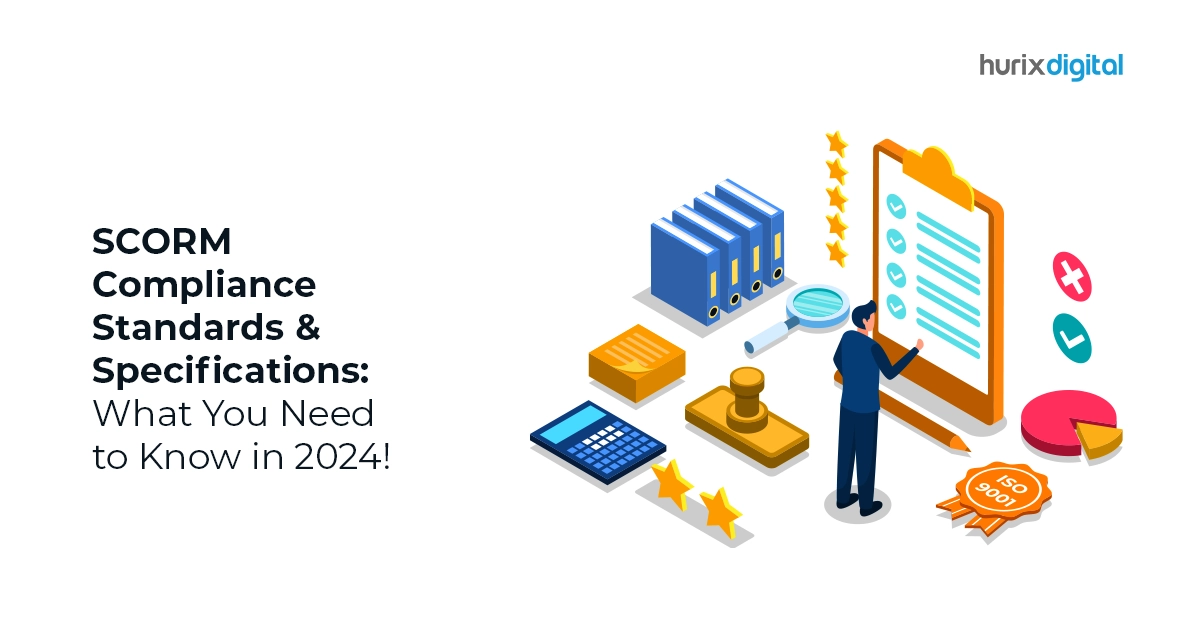Summary
Stay updated on SCORM compliance standards in 2024! Learn about the latest specifications and what they mean for e-learning. Explore key concepts, challenges, and benefits of adhering to SCORM guidelines. Ensure your digital learning content meets industry standards for seamless integration and optimal user experience.
SCORM or ‘Shareable Content Object Reference Model’ is a well-known technical standard to score an eLearning course and ensure that it can work with almost any online LMS (learning management system) to make it more accessible.
Being SCORM compliant is one of the most effective ways of rolling out training quickly and easily across educational institutions as well as businesses. The SCORM guidelines ensure that eLearning courses can be accessed on most learning management systems.
In this post, we will discuss more about SCORM compliance standards and other technical specifications that you need to know in 2024.
Table of Contents:
- What is SCORM Compliance?
- SCORM Compliance Requirements in 2024
- How is SCORM Compliance Assessed?
- The Need for SCORM Compliance
- Conclusion
What is SCORM Compliance?
Earlier, eLearning courses were specific to one learning management system and wouldn’t necessarily work on another. What this means is that if your LMS has issues, you will either end up losing important learning content or have to make a new version.
SCORM was created by the Advanced Distributed Learning (ADL) organization of the U.S. Department of Defense and has since been widely adopted as a tool to standardize the different online course authoring platforms and other software functionalities.
- Today, the SCORM standard is the most widely adopted standard of the eLearning industry. However, for any LMS to create a fully SCORM-compliant course, it needs to follow the technical specifications that are set out in the SCORM guidelines.
- The concept of SCORM module compliance originated out of the need to make eLearning courses more accessible. Once your course is SCORM-compliant, it can be accessed on a wide range of systems instead of only working on one LMS.
- A SCORM package is a structured collection of files and resources that fully conform to SCORM specifications and contain all the required components for delivering e-learning content within a SCORM-compliant learning management system.
- SCORM software is essential for maintaining the reusability, compatibility, and efficient tracking of e-learning content. It enables educational institutions and businesses to develop, oversee, and distribute e-learning materials in a standardized and interoperable fashion, ensuring a uniform learning experience for users on diverse platforms and systems.
- The SCORM course can be effortlessly integrated and utilized across various learning management systems without the need for extensive modifications or customizations.
- While some LMSs come with an integrated course builder that allows you to make content that’s ready for SCORM immediately, you can also use SCORM authoring tools such as Dictera to create content such as assessments, quizzes, etc followed by importing that into your LMS.
- A SCORM authoring tool allows you to take the components of your eLearning course and output them easily in a SCORM-compliant file.
Also Read: eLearning Authoring Tools: Six Popular Tools to Create a SCORM Package
SCORM Compliance Requirements in 2024
To be SCORM-compliant, certain guidelines eLearning content and LMSs need to adhere to. For instance, SCORM-compliant software requires that learning content should meet the below-mentioned conditions to be fully compliant-
- Needs to be in a ZIP file
- Must use Javascript for communication
- Should be described in an XML file
- Must use XML rules for sequencing
While these are the general requirements of SCORM compliance, the criteria for approving compliance for SCORM go far deeper, as discussed in the next section.
How is SCORM Compliance Assessed?
ADL uses three key criteria to assess SCORM compliance with learning materials as described below-
1. Content Aggregation
The SCORM Content Aggregation Model or CAM outlines the way systems and other authoring tools package eLearning content. Put simply, CAM standardizes the way SCORM content is transferred using ZIP files and offers clear and transparent instructions for including metadata that makes training material easily searchable and discoverable for users.
2. Sequencing of Content
The sequencing requirement under SCORM compliance gives the content author complete ability to create rules on how the learner navigates through and between different content modules. It is important to note that these sequencing rules are in XML and offer training managers and course authors the tools to:
- Track as well as monitor learning progress
- Automate remediation opportunities for unmastered skills
- Create easy navigation features for learners
- Give more weightage to specific learning modules that are more important
3. Run-Time Environment
The SCORM Run-Time Environment (RTE) is a compliance requirement under SCORM that handles the exchange of data between the LMS and course content. RTE lays out a proper data model and an API that apply to both sides of the eLearning equation. Put simply, it standardizes communication between the learning management system and the content.
The Need for SCORM Compliance
Ensuring that both LMS and the content you are using are SCORM-compliant helps ensure a much easier and smoother path for content creation and overall usage.
SCORM helps you standardize how the LMS reads and presents your content to learners as well as how the LMS presents quizzes, content, learner scores, and much more.
Here is how SCORM compliance helps educational institutions at various levels-
1. Content Curation
For content creators specifically, following SCORM compliance makes it simple (for both educational institutions and business organizations) to make use of their content.
2. LMS Admins
Another reason why you need SCORM compliance is that deploying SCORM-compliant content into a SCORM-compliant LMS is much faster and easier without requiring technical expertise and customization.
Also Read: Seven Benefits of Using a SCORM-Compliant LMS
Conclusion
If you are ready to make your e-learning content SCORM compliant, Hurix Digital provides digital content solutions that can help you create effective e-learning experiences. Dictera by Hurix Digital, a SCORM authoring tool, can help you completely redefine the process of creating content including assessments.
Dictera uses the power of AI and ML to automate the process of creating assessments, offering authors, Subject Matter Experts (SMEs), and others a whole host of benefits.
To know more about Dictera, contact Hurix Digital today.









